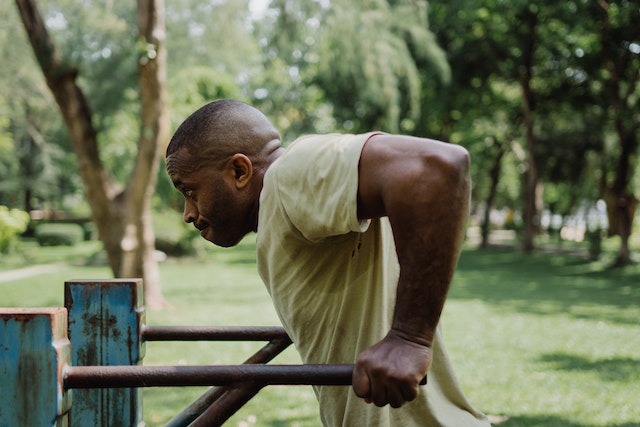Are you tired of doing endless reps of push-ups, squats, and pull-ups, only to see minimal results? Do you feel like you’re stuck in a calisthenics plateau, unable to make any significant gains in muscle growth or strength? Well, fear not, my fellow calisthenics enthusiast! The solution to your problem lies in one simple concept – progressive overload.
Yes, I know, it may sound like a fancy term that only fitness gurus and bodybuilders use. But, in reality, progressive overload is a straightforward principle that anyone can apply to their calisthenics routine. By gradually increasing the difficulty of your exercises over time, you can challenge your muscles to adapt and grow stronger, leading to impressive gains in both muscle mass and strength.
In this article, we’ll delve into the world of progressive overload in calisthenics, discussing its benefits, practical tips for implementation, and common mistakes to avoid. So, whether you’re a seasoned calisthenics practitioner or a newcomer to the world of bodyweight training, get ready to take your workout to the next level!
Understanding Progressive Overload in Calisthenics
If you’re new to the world of fitness, the term “progressive overload” may sound like something out of a science fiction movie. But don’t worry, it’s not as complicated as it sounds. Progressive overload is simply the practice of gradually increasing the stress on your muscles during a workout to promote growth and strength gains.
So, how does this concept relate to calisthenics? Well, calisthenics is all about using your own bodyweight to build strength and muscle mass. And by implementing progressive overload into your calisthenics routine, you can take your bodyweight training to new heights.
There are several ways to apply progressive overload in calisthenics. For instance, you can gradually increase the number of reps or sets you perform for a particular exercise. You can also increase the difficulty of the exercise by adding weight, modifying the range of motion, or trying more challenging variations of the exercise.
To give you an idea of how to apply progressive overload in calisthenics, let’s say you’re trying to build strength in your chest muscles using push-ups. You start with doing 3 sets of 10 push-ups, and after a few weeks, you’re able to complete all sets with ease. To continue making gains, you can increase the number of reps in each set, try more challenging push-up variations like diamond push-ups or wide push-ups, or even add some weight using a weighted vest or backpack.
Think of progressive overload like a video game. The more you progress through the levels, the harder the challenges become. And just like in a video game, as you progress through the levels of your calisthenics training, you’ll become stronger, fitter, and more confident in your abilities.
So, don’t be afraid to challenge yourself and gradually increase the difficulty of your exercises. Your muscles will thank you for it!
The Benefits of Progressive Overload in Calisthenics
Incorporating progressive overload into your calisthenics training has numerous benefits that go beyond just looking good in a tank top. Here are a few reasons why you should consider implementing this concept into your workouts:
- Muscle growth: By gradually increasing the difficulty of your exercises, you can challenge your muscles to work harder and adapt to new levels of stress. This, in turn, can lead to increased muscle mass, giving you a more defined and chiseled physique.
- Strength gains: As your muscles adapt and grow stronger, you’ll be able to perform more challenging exercises with ease. This, in turn, can lead to improved strength in everyday activities, such as lifting groceries or moving furniture.
- Improved performance: By challenging your muscles to adapt and grow stronger, you’ll also see improvements in your overall athletic performance. Whether you’re a runner, a basketball player, or a rock climber, incorporating progressive overload into your calisthenics routine can help you perform better in your sport of choice.
But don’t just take our word for it. Let’s look at a real-life example of someone who has seen the benefits of progressive overload in their calisthenics training.
Meet Joe. Joe is a 35-year-old dad who decided to take up calisthenics to get in shape after years of neglecting his health. He started with simple exercises like push-ups and squats and gradually incorporated progressive overload into his routine. Over time, he increased the difficulty of his exercises, added more reps and sets, and even started doing handstands and muscle-ups.
The results were impressive. Not only did Joe lose weight and develop a more defined physique, but he also gained strength and improved his overall athletic performance. He was able to run faster, jump higher, and even beat his teenage son in a push-up contest.
So, whether you’re a busy parent like Joe or a fitness enthusiast looking to take your workout to the next level, incorporating progressive overload into your calisthenics routine can help you achieve your goals and become the best version of yourself.
Tips for Implementing Progressive Overload in Your Calisthenics Training
Now that you understand what progressive overload is and the benefits it can bring to your calisthenics training, you’re probably wondering how to incorporate it into your routine. Here are some practical tips and strategies to help you get started:
- Track your progress: To effectively implement progressive overload, it’s essential to track your progress. This can be as simple as keeping a journal of the exercises you’re performing, the number of reps and sets, and the level of difficulty. By keeping track of your progress, you can see how far you’ve come and where you need to go next.
- Vary your exercises: While it’s important to focus on specific muscle groups, it’s also crucial to vary your exercises. By doing different variations of a particular exercise or trying new exercises altogether, you can challenge your muscles in different ways, preventing boredom and avoiding plateauing.
- Challenge yourself: It’s easy to get stuck in a comfortable routine, but to see real progress, you need to challenge yourself. This means gradually increasing the difficulty of your exercises, adding more reps and sets, or even trying more advanced variations of an exercise. The key is to push yourself just enough to create a challenge, but not so much that you risk injury.
- Listen to your body: It’s important to challenge yourself, but it’s equally important to listen to your body. If you feel pain or discomfort, take a break and reassess your form or the level of difficulty. Overtraining can lead to injury and setbacks, so it’s essential to find the right balance between pushing yourself and taking care of your body.
By incorporating these tips and strategies into your calisthenics training, you’ll be well on your way to implementing progressive overload and seeing real results. Remember, everyone’s journey is different, and progress takes time. But with consistency and dedication, you’ll be amazed at what you can achieve.
Common Mistakes to Avoid
While progressive overload is an effective way to see results in your calisthenics training, it’s easy to fall into common pitfalls that can hinder your progress. Here are some common mistakes to avoid:
- Progressing too quickly: It’s important to challenge yourself, but it’s equally important to progress at a reasonable pace. Trying to add too much difficulty, reps, or sets too quickly can lead to burnout, injury, or even setbacks in your training. Slow and steady wins the race!
- Neglecting proper form: Form is crucial in calisthenics, and neglecting it can lead to injury or poor results. Before adding difficulty, reps, or sets, make sure your form is on point. It’s better to do fewer reps with proper form than to do many with poor form.
- Ignoring recovery: Recovery is an essential part of training, and ignoring it can lead to overtraining, burnout, and injury. Make sure to get enough sleep, eat well, and take rest days. Your body needs time to recover and rebuild, so don’t neglect it.
- Comparing yourself to others: It’s easy to get caught up in comparing yourself to others, but everyone’s journey is different. Don’t let the progress of others discourage you or make you feel like you’re not doing enough. Focus on your own journey and celebrate your own progress.
By avoiding these common mistakes, you’ll be well on your way to effectively implementing progressive overload in your calisthenics training. And if you do make a mistake, don’t worry – it happens to the best of us! Learn from it and keep pushing forward.
Final Thoughts
Progressive overload is an essential concept to understand if you want to see real results in your calisthenics training. By gradually increasing the difficulty of your exercises, adding reps and sets, and challenging yourself, you can improve muscle growth, strength gains, and overall performance.
But as with any training method, it’s important to implement progressive overload properly and avoid common mistakes that can hinder your progress. By tracking your progress, varying your exercises, challenging yourself, and listening to your body, you can effectively implement progressive overload and see real results.
Remember, progress takes time and dedication, but with consistency and the right mindset, you can achieve your calisthenics goals. So don’t be afraid to push yourself and try new things, and most importantly, have fun with your training! Calisthenics is not just about building muscle and strength, it’s also about enjoying the process and the sense of accomplishment that comes with it.
We hope these tips and strategies have been helpful for you in implementing progressive overload in your calisthenics training. Keep at it, stay consistent, and enjoy the journey!






